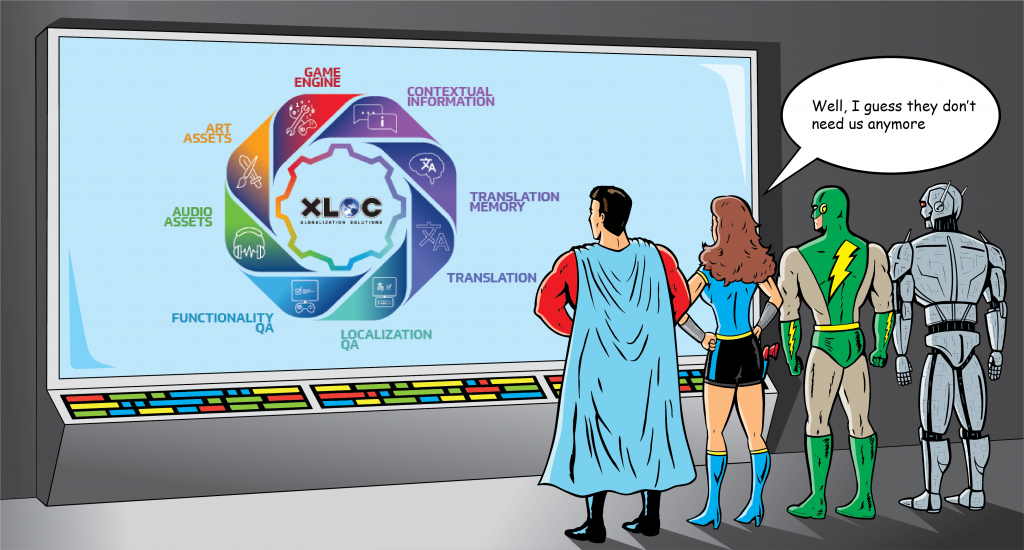
Throughout life, we’re told to not put all our eggs in one basket. Well, when it comes to XLOC and game localization, that’s exactly what you should do.
After a visit from Keyword Studios, one of the leading game localization companies in the world, at the Middlebury Institute of International Studies to give a talk about the game localization, our team wanted to dig a little deeper.
When it comes to getting a document translated, or even an entire book for that matter, it’s as simple as sending the file over to the translator/LSP, who might use a CAT tool to break apart the strings, but that’s about as technical as it usually gets. However, when it comes to video game localization, its like playing Operation, where you have to surgically remove the strings for translation, being careful not to touch the sides (the code that your strings are housed in) or otherwise you might just break your build.
At which point we were introduced to XLOC, a content management system (CMS) specifically tailored to game localization.
Two members of Keyword Studios, Jenny McKearny and Rebecca Guttentag graciously gave us a demo of the ins and outs of XLOC so we could see is integral role at the center of the game localization process.
In a nutshell, XLOC serves as a central repository for all strings and related assets involved in a given project. ALL members of the various teams have access to this data, including translators, PMs, reviewers, and developers (though access may vary depending on role).
To learn more about XLOC, please visit their website.
In this post, I will talk about the advantages of having a CMS like XLOC and how this may be even more essential than a TMS.
CMS vs TMS
A CMS and a TMS have two things in common—the M and the S—they are Management Systems. Where they differ is what they manage. A CMS manages content, that is, the strings and assets tied to those strings, and serves as a overall central repository. A TMS, on the other hand, handles the translation, managing TMs, TBs, importing and exporting strings within the translation editor, etc.
When it comes to game localization, a CMS may be even more important than a TMS. Why? It’s all about protecting the build, one that is being constantly updated. A CMS can serve as a sort of middleman or gatekeeper, between the original build being developed and the translation tools. The strings meant for translation can be checked for errors, so that broken strings that are translated are not put back into the build.
Within the CMS, healthy strings can be housed, sorted, grouped, along with the accompanying assets for the translators, providing context for accurate translations. Strings and assets can be categorized and tagged with additional metadata, not only allowing the translator to understand how they fit into the context of the game, but allowing the PM to organize them and guide the localization process accordingly (by chapter, character, etc.)
XLOC makes this a seamless process through end-to-end automation, where you just let it know what is meant for translation, and it will take care of the rest. Once translations are completed, LQA can be done within XLOC before being sent back to the game build.
Integration, integration, integration
Where XLOC truly shines is its integration with additional software via API. XLOC itself serves as a central repository and manages the content if additional functionality is needed, software that specializes in the desired functionality can be tied in and integrated.
One example of this integration is the recently developed memoQ connector announced by XLOC. This allows for seamless transfer of strings to MemoQ at the click of a button, without the messy process of manual downloading and uploading of files.
Different types of integration can aid at various stages of the localization process. As the MemoQ connector takes the burden off of engineers and PMs, other types of integration may help translators as well. For example, one type of integration I would like to see is software that can help to give improved visual context to translators, instead of simply manually importing individual assets. One example of this type of software is Hydra, a global repository used by Netflix to house and display image files of screenshots where text is present. Though Hydra does not take the screenshots itself (additional back-end automation would need to be implemented as well), it has functionality that allows the translator to see how the user would see the text displayed at any moment. Integration with this type of software would improve the quality of the translations upstream, thus reducing LQA.
Integration gives XLOC the ability to adapt to the client’s needs and removes the burden of purchasing a slew of unneeded features. As Lao Tzu put it, “Simplicity is the ultimate sophistication.”
What we’d like to see
XLOC is an amazing tool, but it does have limitations. Here are a few recommendations for future development:
- At the moment, the only assets that are allowed to accompany strings are audio and image files. As video games are quite dynamic, video files (e.g., cut-scenes, dialogue-heavy gameplay) could be very useful to translators. The inclusion of video files as assets could be very useful for yielding accurate translations.
- XLOC serves as a link between all stakeholders in a localization project. This link is made through the online web, but only while online. If a stakeholder does not have access to the internet for whatever reason, he/she cannot make use of the central repository, thus potentially slowing down the process. A desktop version of XLOC that can be used online (and then updated once internet connection is reestablished) would be very beneficial to the overall flow.
- Before importing the translated strings into the game build, it would be nice to see what it’s gonna look like! We have seen in-context or WYSIWYG editors in CAT tools, such as SDL Trados (though these are limited to specific documents/file types). Some sort of in-context preview built into XLOC that is able to interact with the assets to show visual reference and identify potential errors would make the LQA process run much more smoothly.
Next Steps
XLOC is a very powerful tool and its integration and customization abilities make it an ideal choice for game developers. The next step is to take a look inside MemoQ’s Translation Management System to see why it is XLOC’s preferred choice and if there are any suggestions we could make to improve its functionalities even further. And who knows, there may be another super-TMS tailored to game localization lurking around the corner!
Thank you for reading and thank you again to Keyword studios and XLOC!


